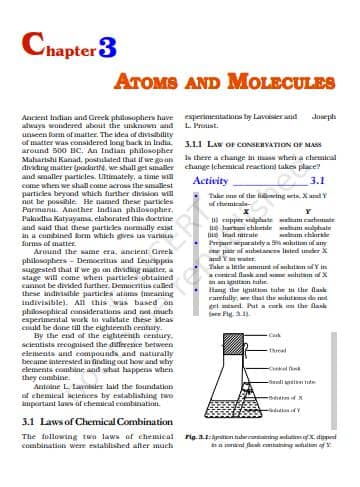‘Atom And Molecules Class 9’ PDF Quick download link is given at the bottom of this article. You can see the PDF demo, size of the PDF, page numbers, and direct download Free PDF of ‘Atom And Molecules’ using the download button.
Atoms And Molecules Class 9 PDF Free Download

Science Class 9 Notes – Atoms and Molecules
Law of conservation of mass: This law was stated by Lavoisier in 1744. It states that “In all physical and chemical changes, the total mass of reactants is equal to the total mass of products.”
Law of constant proportions (or constant com-position): This law was first stated by Proust in 1797. According to the law “a chemical compound is always found to be made up of the same elements combined together in the same proportions by weight” e.g. the ratio of hydrogen and oxygen in pure water is always 1: 8 by weight. This law is also called the law of definite proportions.
Dalton’s Atomic theory: Postulates of Dalton Atomic Theory
• Matter is made up of extremely small indivisible particles called atoms.
• Atoms of the same substance are identical in all respects i.e., they possess the same size, shape, mass, chemical properties, etc. Atoms of different substances are different in all respects i.e., they possess different sizes, shapes, mass, etc.
• Atom is the smallest particle that takes part in a chemical reaction.
• Atoms of different elements May combine with each other in a fixed simple, whole number ratio to form compound atoms.
• Atoms can neither be created nor destroyed i.e., atoms are indestructible.
Atom: It is the smallest particle of an element that can take part in a chemical change. It may or may not be capable of independent existence.
Symbol: The abbreviation used for lengthy names of elements is termed as their symbols. The symbol of an element is the first letter or the first and another letter of the English name or Latin name of the element. While writing a symbol, the first letter is always capital and the second is always small.
Molecule: It is the smallest particle of an element or compound that is capable of independent existence and shows all the properties of that substance.
[The molecules of an element is made up of only one and the same type of atoms, while the
molecule of a compound is made up of dissimilar atoms]
Atomicity: The number of atoms present in a molecule of an element or a compound is known as its atomicity. e.g. the atomicity of oxygen is 2 while the atomicity of ozone is 3.
Ion: It is an electrically charged atom or group of atoms. It is formed by the loss or gain of electrons by an atom. Ions are of two types :
(i) Cation: It is a positively charged ion and is formed by the loss of an electron from an atom e.g.
H+, Na+, Ca2+, Al3+, NH4 etc.
(ii) Anion: It is a negatively charged ion and is formed by the gain of electrons by an atom, e.g. etc.
Valency: The combining power (or capacity) of an element is known as its valency.
The formula of simple and molecular compounds Binary compounds are those compounds that are made up of two different elements e.g. NaCl, KBr, CaO, etc. Following rules are to be followed for writing the formula.
(i) The valencies or charges on the ions must be balanced.
(ii) For a compound made up of a metal and a non-metal, the symbol of metal is written first.
(iii) In compounds formed with polyatomic ions, the ion is enclosed in a bracket before writing the number to indicate the ratio.
The atomic mass of an element: The atomic mass of an element is the numerical number that indicates how many times an atom of an element is heavier than 1/12 of the mass of an atom 12 of carbon-12.
For example, the atomic mass of magnesium (Mg) is 24 which indicates that one atom of magnesium is 24 times heavier than 1/12 of a carbon-12 atom.
Gram atomic mass: The atomic mass of an element expressed in grams is known as gram
atomic mass. (Gram atomic mass is also known as gram atomic weight)
Molecular mass: The number of times a molecule of a compound is heavier than 1/12 of the mass of the C-12 atom, which is known as its molecular mass.
The molecular mass is equal to the sum of the atomic masses of all atoms present in one molecule of the substance. For example, H2 contains two atoms of hydrogen, so the molecular mass of H2 is 2 (2 x 1 =2)
Formula unit mass: It is equal to the sum o the atomic masses of all the atoms in a formal unit. In case of ionic compounds like NaCl formal mass is 58.5 (23 + 35.5 = 58.5)
Molecular Mass and Mole Concept: Mole the unit of a substance. It is a collection of 6.023 x 1023 particles. The mass of 1-mole particles is equal to its mass in grams.
Thus 1 mole = 6.023 x 1023 particles
1 mole atoms = 6.023 x 1023 atoms
| Author | – |
| Language | English |
| No. of Pages | 15 |
| PDF Size | 1 MB |
| Category | Subject |
Related PDFs
The Ethics Book PDF By Benedict de Spinoza
Atom And Molecules Class 9 Notes Book PDF Free Download
